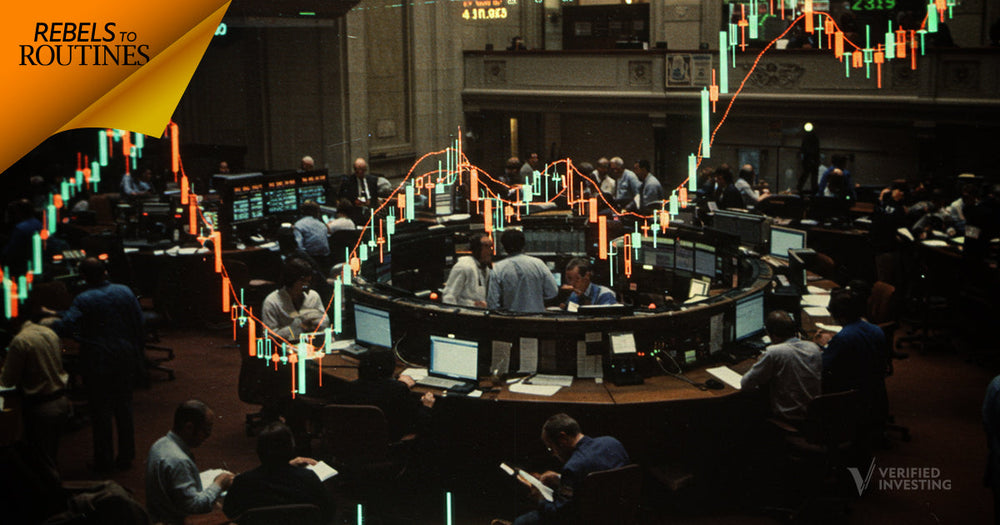Options Derivatives: From Speculative Side Bets to Core Trading Tools

Tracing their early skepticism, revolutionary breakthroughs, and mainstream acceptance.
From the Backrooms to the Boardrooms
In the late 1960s, a select circle of traders gathered in Chicago’s backrooms and the “open outcry” pits, exchanging handshake agreements on calls, puts, and forward contracts. These so-called “side bets” were often poorly understood by outsiders—viewed as borderline gambling rather than legitimate financial strategies. Even the term “derivative” carried a slightly dubious ring, suggesting something artificial, risky, and unwieldy.
Fast-forward to modern times, and options and derivatives are everywhere. From a soybean farmer hedging against crop price fluctuations to a Fortune 500 treasury department locking in currency exchange rates, derivatives have become a standardized, globally recognized method of managing risk and generating returns. Exchanges like the Chicago Board Options Exchange (CBOE) and CME Group clear staggering volumes daily. Hedge funds, mutual funds, and even individual traders on mobile apps use call or put options to hedge positions, speculate on market movements, or earn steady premium income.
So, what changed? A blend of academic breakthroughs, improved regulation, and real-world crises that highlighted the power—both good and bad—of derivatives. The transformation wasn’t always smooth; controversies persist about leverage, moral hazard, and the role derivatives played in financial meltdowns like 2008. Yet there’s no denying that once upon a time, most of Wall Street shrugged off or even shunned these instruments. Today, they’re a fixture in virtually every major financial market.
Join us as we dive into the storied past of options and derivatives trading: from its “shady” beginnings to its academic underpinnings, its big turning points, and its emergence as a mainstream tool for everyone from retail hobbyists to global institutions.
Early Origins & the Seeds of Skepticism
The basic concept of a derivative—an agreement whose value stems from an underlying asset—dates back centuries. In 17th-century Japan, rice farmers signed early forms of futures contracts. Meanwhile, in Europe, merchants used forward contracts to lock in prices for grains and spices. Even so, these transactions remained an afterthought in the broader financial narrative, overshadowed by more straightforward methods like stock and bond trading.
By the mid-20th century, derivatives traded “over the counter” (OTC) through private negotiations—largely unregulated and lacking consistent standards. Market participants worried about counterparties failing to honor their obligations. The contracts were also notoriously complex; each deal could have customized conditions, leaving little transparency or liquidity. Many viewed these instruments as purely speculative side deals, suitable only for the most daring traders.
Skepticism abounded. Traditional brokers and investors saw derivatives as risky wagers. The media occasionally ran exposés on “futures gamblers” who lost fortunes by betting the wrong way on commodities like wheat or pork bellies. Shareholders in major companies questioned whether dabbling in derivatives put corporate assets at risk. Even the academic world mostly ignored derivatives—no formalized pricing models existed to explain how options should be fairly valued.
It was in this climate of distrust and uncertainty that some crucial seeds were sown. A handful of progressive thinkers believed there had to be a more rigorous approach to understanding derivatives. They posited that, under certain assumptions, one could mathematically calculate the fair price of an option or future contract. This idea was about to collide with real-world markets in spectacular fashion.
Indeed, the next decade would see a seismic shift in how the financial industry viewed these instruments, catalyzed by new exchanges, standardized contracts, and groundbreaking research that brought a theoretical framework to the once-murky domain of derivatives.
Key Pioneers & Historic Milestones
Fischer Black, Myron Scholes & the Black–Scholes Model
Arguably the most pivotal moment in the history of options trading came in 1973, when Fischer Black and Myron Scholes published their groundbreaking paper introducing a formula for pricing European-style options. The Black–Scholes model provided, for the first time, a mathematically rigorous approach to calculating the “fair value” of an option based on variables like the underlying asset’s price, time to expiration, risk-free interest rate, and volatility. Robert Merton further extended this work, winning a Nobel Prize (along with Scholes) in 1997 (Black had passed away and was thus ineligible for the Nobel).
The Launch of the Chicago Board Options Exchange (CBOE)
Also in 1973, the CBOE opened its doors. It offered standardized, exchange-traded stock options with set strike prices and expirations, a revolution in an arena previously dominated by ad hoc OTC arrangements. This standardization improved liquidity, transparency, and trust. Suddenly, anyone could buy or sell a listed call or put without having to craft a bespoke contract.
CME and Further Commodities Innovations
Commodities got their own standardized derivatives push earlier, with the Chicago Board of Trade (CBOT) and later the Chicago Mercantile Exchange (CME) formalizing futures contracts on everything from corn to livestock. Over time, these contracts became a staple for farmers, food processors, and speculators aiming to manage price volatility.
Growth of Currency and Interest Rate Derivatives
As global trade flourished, corporations needed ways to hedge against currency risk. In the 1970s and 1980s, currency futures and options emerged as indispensable tools. Next came interest rate derivatives like swap agreements, allowing companies to exchange fixed-rate interest payments for floating-rate ones (or vice versa). Banking giants began using swaps to manage fluctuating rates, turning derivatives into a multi-trillion-dollar global marketplace.
The Nobel Seal of Approval
When Scholes and Merton received the Nobel Prize for their work on option pricing in 1997, it marked a new era of academic legitimacy for derivatives. Universities started incorporating derivatives courses into finance curricula, and an entire generation of “quants” emerged, eager to apply complex math to real-world trading desks.
By the late 1990s, derivatives were no longer fringe instruments reserved for agricultural speculators or specialized currency traders. They had become a standard part of risk management in industries as varied as oil refineries, airlines, and multinational conglomerates. This newfound respect, however, would be tested in the following decades as the global financial system contended with the dark side of leverage and mispricing in exotic derivatives.
The Tools & Techniques That Changed Everything

Modern derivatives trading rests on a suite of core products and techniques that gave these instruments unprecedented adaptability—and complexity.
-
Calls & Puts
- Definition: A call option grants the right (but not the obligation) to buy an underlying asset at a set price (strike) before a certain date. A put option grants the right to sell.
- Why It Mattered: Traders and investors gained a flexible instrument for hedging or speculating. You could lock in a purchase price or protect against potential drops—without committing all your capital upfront.
-
Futures Contracts
- Definition: Standardized agreements to buy or sell an asset at a predetermined price on a future date.
- Key Utility: Provides clarity and reliability for both hedgers (e.g., farmers, airlines, importers) and speculators. The standardization also boosts liquidity and price transparency.
-
Swaps (Interest Rate, Currency, Credit)
- Definition: OTC contracts to exchange one set of cash flows for another. For instance, swapping a fixed interest payment for a floating one.
- Impact: Opened the door to refined risk management strategies. Companies with large debt loads could rearrange interest payments to suit their financial outlook, while international businesses could hedge currency exposures in cross-border transactions.
-
Exotic Options & Structured Products
- Examples: Barrier options (knock-in, knock-out), binary options, and complex baskets tying multiple assets together.
- Pros & Cons: These instruments can be tailored to highly specific risk profiles—often beneficial for advanced hedgers. But their complexity can obscure embedded risks, leading to potential blow-ups if not well understood.
-
Greeks & Risk Metrics
- Core “Greeks”: Delta (rate of change in option price relative to the underlying), Gamma (rate of change of delta), Theta (time decay), Vega (sensitivity to volatility), and Rho (interest rate sensitivity).
- Why They’re Crucial: Provide a detailed map of how an option might react to changes in market conditions. Sophisticated traders manage “Greek risk” to keep portfolios balanced under shifting scenarios.
-
Pricing Models & Volatility Analysis
- Black–Scholes as a Baseline: It started the wave, but modern approaches can incorporate stochastic volatility, jumps, and correlations across assets.
- Implied vs. Realized Volatility: Traders compare what the option market implies about future volatility with actual historical volatility. This “volatility arbitrage” is a key driver in advanced derivative strategies.
All these tools and techniques evolved in tandem with better technology. The rise of computerized trading platforms made real-time pricing possible, enabling continuous updates to pricing models. Over time, these innovations took derivatives from an opaque labyrinth to a transparent marketplace—though skeptics would argue “transparent” is a relative term, given the extraordinary complexity behind some derivative products.
Pros & Cons of Derivatives Trading
Pros
-
Risk Management
- Hedging Power: Airlines can hedge fuel prices with crude oil futures; farmers can lock in a sale price for wheat; corporations can insure against currency swings.
- Protecting Portfolios: A put option on an index can function like insurance, limiting losses in a downturn.
-
Leverage & Capital Efficiency
- Lower Capital Outlay: Buying an option requires a fraction of the capital compared to buying the underlying asset outright.
- Enhanced Returns: Skilled traders can amplify gains on correct market calls (though the opposite is equally true).
-
Flexibility & Customization
- Tailored Strategies: Derivatives can be structured to suit specific market views—bullish, bearish, or neutral.
- Income Generation: Selling options (e.g., covered calls) can provide a steady premium income.
Cons
-
Complexity & Mispricing
- Steep Learning Curve: Options greeks, implied volatility, margin requirements—derivatives jargon can overwhelm even seasoned traders.
- Underestimating Risk: Complex or exotic derivatives can harbor hidden pitfalls, as the 2008 financial crisis painfully demonstrated.
-
Leverage-Driven Losses
- High Stakes: While leverage can magnify gains, it also multiplies losses, potentially wiping out entire accounts swiftly.
- Margin Calls: A sudden price move against a leveraged position can trigger margin calls, forcing liquidation at a bad time.
-
Systemic Risk
- Chain Reactions: In major crises, the interconnected nature of derivative contracts can ripple across markets, leading to liquidity shortages and even defaults.
- Regulatory Gaps: Some derivatives still trade OTC, which can obscure exposures and magnify contagion risk.
In short, derivatives are powerful, but with power comes responsibility. Used prudently, they’re brilliant tools for hedging, income generation, and portfolio optimization. Misused, they can quickly devolve into catastrophic losses—not just for individuals but entire institutions and economies. Balancing these pros and cons lies at the heart of modern risk management practices.
How Options & Derivatives Became a Mainstream Standard
What key developments propelled derivatives from the fringes to an accepted norm? Several milestones stand out:
-
Academic Validation & the Nobel Factor
- Once the Black–Scholes model and subsequent refinements gained traction—crowned by a Nobel Prize—derivatives were no longer considered wild guesswork. If top academics deemed them mathematically sound, institutions felt more comfortable adopting them.
-
Exchange Standardization & Clearing
- The CBOE and CME (among others) introduced standardized contract specifications, clearinghouses, and margin systems. This drastically lowered counterparty risk and increased transparency, two of the biggest hurdles historically holding derivatives back.
-
Technological Advances
- The proliferation of real-time data feeds and online trading in the 1990s and 2000s made derivatives more accessible. Retail traders could suddenly track options prices, implied volatility, and greeks on user-friendly platforms. Institutions implemented automated risk engines to manage complex portfolios.
-
Global Market Integration
- As multinational corporations expanded, currency and interest rate hedging became imperative. Derivatives provided straightforward solutions to cross-border exposure. This organic demand from corporates helped normalize derivatives as standard corporate finance tools.
-
Inclusion in Academic & Professional Curricula
- Finance programs worldwide began incorporating derivatives modules. Professional designations like the CFA or FRM (Financial Risk Manager) included substantial derivatives sections, reinforcing their legitimacy in the broader finance community.
-
Regulatory Frameworks
- Various reforms (like the Dodd–Frank Act in the U.S.) aimed to rein in high-risk OTC derivatives, pushing more contracts onto exchanges. This regulatory nudge accelerated the shift toward standardized, transparent instruments.
Despite widespread acceptance, public perception of derivatives has been shaped by periodic market blow-ups. The infamous LTCM (Long-Term Capital Management) fiasco in 1998, or the mortgage-backed security (MBS) meltdown in 2008, are cautionary tales of how derivatives can implode on a grand scale. Yet these crises also spurred better oversight and forced industry players to refine their risk models.
By the mid-2010s, derivatives were an established mainstay in portfolio management, risk hedging, and institutional asset allocation. From central banks setting monetary policy to individual traders selling weekly covered calls, these once-arcane instruments had truly arrived at center stage—solidifying their transition from a questionable gamble to a near-universal finance tool.
Conclusion & What’s Next

Derivatives have traveled a tumultuous road—from handshake deals in backrooms to globally regulated, exchange-listed products. Initially dismissed as fodder for high-stakes gambling, they’ve proven to be invaluable for hedging, liquidity, and precise market exposure when used responsibly. Yet their capacity for swift, sometimes devastating financial impacts remains a double-edged sword.
Still, in the span of just a few decades, the adoption of exchange-traded options and futures has become so common that many find it hard to imagine modern markets without them. Students learn Black–Scholes as a staple in finance classes. Corporate treasurers see currency hedges as essential to global operations. Farmers rely on futures to protect the livelihood of their harvests.
With that, we wrap up the third installment of Rebels to Routines: The Surprising Rise of Modern Trading Standards. We’ve seen how a once shadowy corner of finance grew into a powerful, widely accepted force.
Up Next: We’ll take a closer look at Indexing & Passive Investing—another concept that began as a curious deviation from active stock-picking yet became one of the world’s most influential investment strategies. Stay tuned to learn how “just match the market” flipped the script on conventional wisdom and reshaped investing for millions.
Trading involves substantial risk. All content is for educational purposes only and should not be considered financial advice or recommendations to buy or sell any asset. Read full terms of service.




